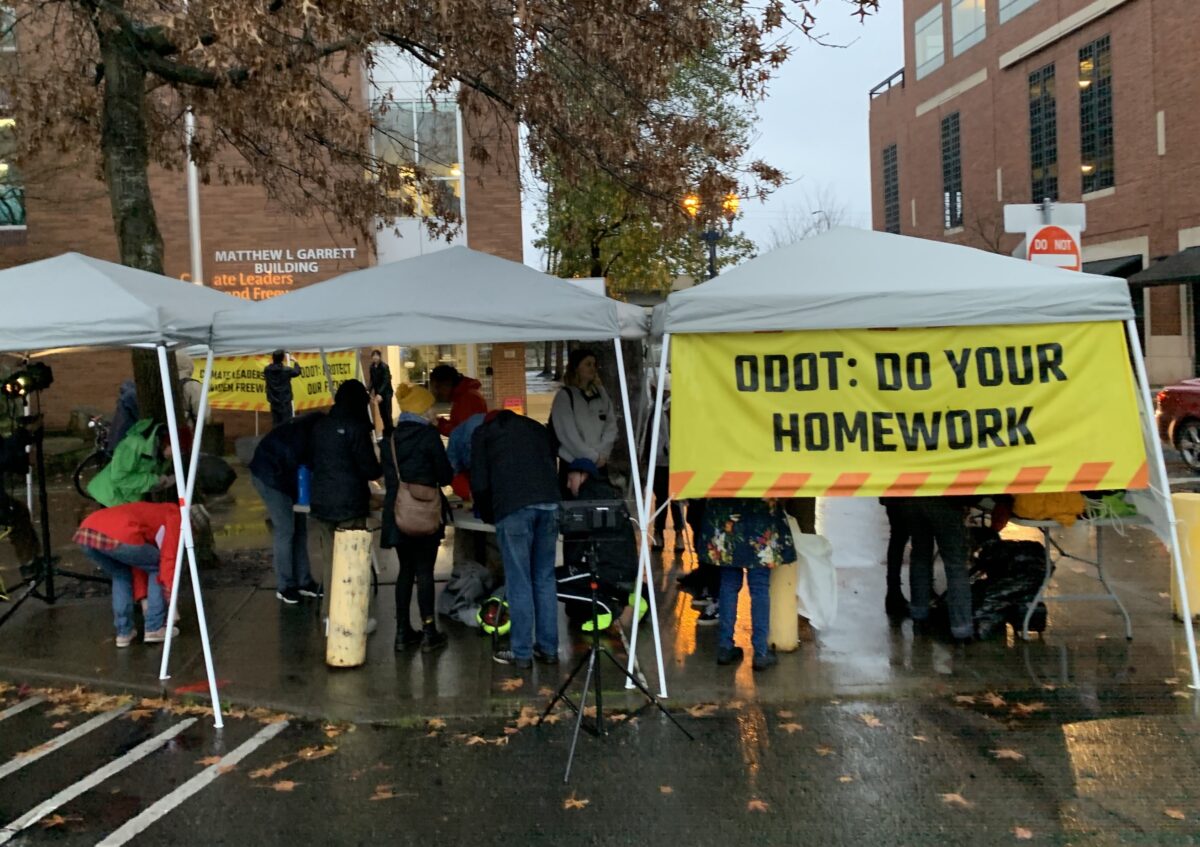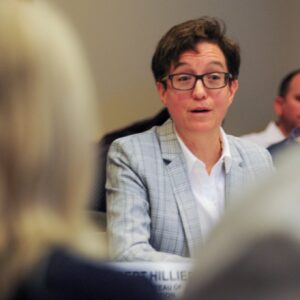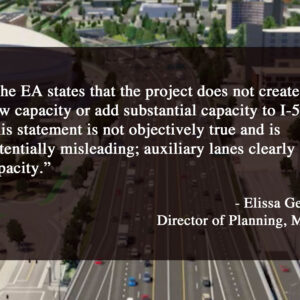
(Photo: No More Freeways PDX)
“We continue to have concerns about the stewardship and outcomes of the Project.”
— Letter signed by Portland Mayor Wheeler, Metro President Lynn Peterson, Multnomah County Commissioner Jessica Vega Pederson, and Portland Commissioner Chloe Eudaly
Just days before the Oregon Transportation Commission will weigh in, Portland Mayor Ted Wheeler has joined the growing chorus calling for more in-depth environmental review of the I-5 Rose Quarter project.
Wheeler has sent a letter (PDF) to Oregon Governor Kate Brown and OTC Chair Robert Van Brocklin calling for a full environmental impact statement (EIS). The letter is signed by Metro President Lynn Peterson, Multnomah County Commissioner Jessica Vega Pederson, and Portland Commissioner Chloe Eudaly. (Eudaly already called for the EIS back in April.)
Here’s an excerpt from the letter:
Since the inception of the Project, we’ve worked closely with ODOT and other partners to advance a meaningful concept, offer constructive feedback and raise concerns. Over the past six months, our agencies have participated in an informal process with the Oregon Transportation Commission (OTC) with the sincere desire to collaboratively pursue a path forward.
The OTC has yet to articulate how our input would be addressed or how our recommendations would be incorporated. We continue to have concerns about the stewardship and outcomes of the Project.
Advertisement
The letter states that ODOT hasn’t made adequate progress on several things the City of Portland, Multnomah County, and Metro has been asking for. Those include: Adoption of a leadership policy that, “reflects values of transparency, inclusivity, and transportation justice”; a project charter that lays out a decision-making structure with community representation and oversight; and a third-party study on the proposed highway covers.
ODOT completed an environmental assessment (EA) for the project back in February as part of the federal National Environmental Policy Act (NEPA) process required for large transportation projects. ODOT has said the EA is sufficient and has thus far been reluctant to do a more robust EIS. The more rigorous assessment would stall the project and require ODOT to address several controversial elements like its impact on air quality around Harriet Tubman Middle School, its impacts on greenhouse gas emissions, the design of proposed highway covers, and more.
In April, Metro’s senior planner said ODOT’s EA was “inadequate and potentially misleading”.
Leaders and organizations throughout the region have been pressuring ODOT to slow down and do the EIS. Pressure has been coming not just from activist groups like No More Freeways PDX (who held a rally on Tuesday in front of ODOT’s Region 1 headquarters), but also from the Portland Public Schools board, Albina Vision Trust, Oregon House Speaker Tina Kotek, State Senator Michael Dembrow, and others.
Wheeler has faced relentless pressure from groups like No More Freeways and Sunrise Movement to come out more strongly against the I-5 project. At the rally on Tuesday they held up banners saying “Climate Mayors Don’t Widen Freeways” and “ODOT: Do Your Homework”.
Reached for comment today, No More Freeways leader Aaron Brown said, “We’re grateful that local elected officials realized they could no longer ignore the thousands of constituents, community organizations, and youth climate leaders who correctly pointed out months ago that ODOT’s abysmal freeway expansion proposal warrants far greater scrutiny and better community engagement.”
The OTC meets Tuesday and is expected to make a final decision on the EIS issue. The ball is in the OTC’s court because — despite calls for an EIS from leaders, organizations and hundreds of Oregon residents — ODOT staff forwarded the issue to the OTC agenda without any recommendation of their own.
— Jonathan Maus: (503) 706-8804, @jonathan_maus on Twitter and jonathan@bikeportland.org
— Get our headlines delivered to your inbox.
— Support this independent community media outlet with a one-time contribution or monthly subscription.






Thanks for reading.
BikePortland has served this community with independent community journalism since 2005. We rely on subscriptions from readers like you to survive. Your financial support is vital in keeping this valuable resource alive and well.
Please subscribe today to strengthen and expand our work.
Hey Ted, Sarah Ianarrone was with us there in the rain. Not only do climate leaders not widen freeways, they resist them from the start.
I’m frankly surprised that the other commissioners did not sign on to the letter. I have attended several city council hearings on climate change and related issues in support of Extinction Rebellion and Sunrise Movement, and the all clearly “get it”. Were the others not asked?
What I think council needs to hear is that we want them to push harder and move more aggressively than they currently feel comfortable doing. Knowing there is political backing for doing so will help immensely.
And while related to climate change how is this related to biking besides maybe a tangential argument related to fungibility of funding?
Big picture: street space is a zero sum game. The easier/more convenient you make it for private autos, the tougher you make it for vulnerable road users (people walking or using a bicycle.) Highway style roads are great for car commuters (assuming they survive the journey that is) but walking/bicycling along-side roads like 82nd and TV highway is an awful experience. It’s a near perfect inverse relationship.
The easier you make it for suburban commuters to drive downtown, the more cars you’ll have (in downtown and throughout the region.) And by doing so you’ll continue to create car-centric constituencies who will continue to demand more and more car infrastructure. I would argue the biggest “winners” in a RQ expansion project are exurban landowners who can market their properties for development with the (briefly attainable)promise of a slightly shorter daily commute…..until enough of that land is developed and travel times return to where they are now.
I could (and do) argue that you should be working hard to *reverse* the imbalance between road space available for private autos versus that which is available for all others; but even if that’s not on offer right now, creating more space for private autos is certainly opposed to the interests of the bicycling community in Portland.
I’m sure this has been suggested before, but why not focus on moving people instead of cars, by using the funds for this section of I-5 to un-build the freeway and convert it into a street-level boulevard? Since the roadway is already congested, it won’t make it any worse, and long-distance interstate freight really ought to be moving by rail anyway. Granted there isn’t enough space to create another McCall Park (the last I-5 to be un-built, back in the 70s), but at least urban building footprint can be reclaimed to extend the downtown further into the east side.
@David Hampsten – The freeway keeps traffic funneled and off of surface streets. I would be concerned that google maps would route cars to the old state highway routes if I5 was an open boulevard. That would be Barbur, 5th, Naito/Front, MLK, Interstate, Vancouver Ave, Sandy etc.
But that’s the crux of the matter. A freeway only works if you have enough funding and space to keep expanding the roadway as traffic increases. Oregon has for the last 30+ years amply demonstrated that it neither is willing to keep expanding freeways nor pay for building them, unlike its neighbors. It’s not even willing to pay for maintaining them. So instead of going through a series of false starts and protests over what in most other states would be a minor expansion of an existing freeway, Oregon needs to re-examine how it will move the people and goods passing through Portland, based upon its transportation culture and political will.
If Portland wants to demonstrate national leadership in transportation alternatives within its context of not raising enough money to build 20-lane freeway funnels, which your increasing traffic would normally warrant, I believe it needs to eliminate roadways it cannot afford to maintain such as I-5, I-405, & I-205, and reroute traffic onto city streets. The ensuing congestion may be horrible for a time, but on the long run it will encourage users to use alternative routes or to not even drive at all, but to use rail, rapid bus, and other means instead. The congestion will also slow car traffic to manageable speeds, increasing the safety of other users such as bicyclists, walkers, and local transit users.
It helps to keep in mind that Portland’s geography is its greatest asset – there’s no vast plain around it that allows for some other vast freeway to bypass it, but instead the mountains and sea funnel all of the west coast traffic between LA and Seattle into Portland – so I suggest you take advantage of it. Force those 150,000 cars per day to drive 20 mph through urban Portland, stopping to buy stuff, stay in your hotels, visit your city. Make Portland the biggest traffic calming device in the USA.
“The freeway keeps traffic funneled and off of surface streets”
Of course, that’s not true. All of the streets you mentioned are full of cars too.
It plays out the same way in every major metro area in the world; the more space you allocate for cars, the more cars you get.
Maybe it’s not. Maybe all that money could be spent on cycling infrastructure. Maybe all that money could be spent on safe pedestrian infrastructure which would benefit cyclists by getting people out of their cars. Maybe getting people out of their cars will encourage local gov’t to build safe cycling and pedestrian infrastructure. Maybe all this money could be spent on improving transit which would get people out of their cars which could benefit cyclists. Etc etc.
All that money?
Last time I checked we don’t actually have that money. We would need to borrow it, and pay interest to dastardly banksters for decades.
It is a bit late, but I am happy to see Wheeler finally come around. Kate Brown has been shockingly bad on this and other climate issues – when will I ever learn to not hold out hopes for our electeds?
hmmm. Are we viewing this project solely through the lens of today’s Portland or the one the will have Rose Lanes and more reduced driving lanes/ access. My guess is that it is today’s Portland which isn’t an accurate picture. Reminds me of PBOT’s favorable data collection practices… somehow it’s always in their favor…
We still need public comments! This is great news, but if you haven’t already, please email the Governor and the Oregon Transportation Commission to move forward with an EIS:
http://www.nomorefreewayspdx.com/demandanEIS
Good coverage JM. Just read the piece in The Oregonian about this and could not make sense of it.
OTC should be directing staff to figure out how we decommission urban freeways, not how to widen them. They should never have been built.
Looks like Ted is looking for some votes with minimal downside. I mean, really, it’s fine if ODOT blows him off. Portland has always capitulated to ODOT. It’s too bad they have to call in the nuke strike (climate change) just to stop one expansion that makes no sense. It should just be logical. But now it’s got all this climate change religion all over it. Personally, once it gets there, I am out. An interchange is going to make zero difference in terms of Africa’s or Alaska Climate. The real issue is how it negatively impacts the school and people around the freeway. But I guess nobody cares (in government) about those real issues for those real people that live in Portland.
I guess whatever gets it done? But really, how many times can one cry wolf?
It’s not crying wolf.
–Building stuff releases CO2.
–Covering soil with pavement reduces CO2 uptake.
–One project implies another. Multnomah County gets so many lane miles, Clackamas and Washington Counties will want theirs. Wait, now there’s a bottleneck up the road. Send more concrete trucks.
Concrete isn’t a cheap neutral material. The stuff that goes into it is mined, crushed, hauled, baked at a very high temperature, hauled some more, mixed…there’s water pollution, lots of CO2, dust, and big trucks taking up space on the roads you drive. It’s a great material but it’s not free.
We have to look at other options besides building things. Driver training, car pooling incentives, enhanced transit. Every person who gets out of the SOV trap makes things easier for those who can’t or won’t.
You’re right, air pollution does not go straight to Africa or the Arctic. First we get to run it through our lungs and then we share it with our neighbors.
This!
Take a hint from today’s U.S. Forest Service and BLM when EIS’s are required. When a timber firm wants to cut a swath of old growth on public land, the Forest Service lets them write their own EIS. When a mining company wants a mine on public land, the BLM lets them write their own EIS.
Bottom Line: EIS’s are no longer a roadblock.
Read the letter and you’ll be able to answer your own question.
There are and have been other expansion projects going on. No more freeways didn’t do anything about those . There is construction going on all the time. This expansion makes no sense just on it’s merits. No need to make it bigger than it is. It’s just a money wasting, bad project.
Glad momentum is building on this. For such a large and critically impactful project to not have an EIS is ridiculous. Maybe ODOT will be forced to actually back up their data and give a straight answer about whether they think it will increase capacity or not.
There seems to be an impression here (and not addressed in the article) that an EIS is some sort of substantive legal hurdle. It is only a procedural requirement (if it is required at all), and even with one that has a finding of “significant environmental impact” (how could it not?), the project can still go forward.
It’s a meaningless distraction to focus on EA/EIS — one that people here seem only to happy to take part in.
The real issue is whether we are going to continue building fossil fuel infrastructure. Maybe try focusing on that instead.
A rare day. 9watts agrees with The Dude.
The Dude,
Thanks for mansplaining what at an EIS is. Pretty sure many of the activists realize that it’s just a document and that it’s not the silver bullet needed to kill the project. But to call it a “meaningless distraction” is very disrespectful to all the work being done.
Do you think it’s meaningless to force ODOT to do something they don’t want to do? Or to force them to make a significant delay in a project they clearly want to ram through as quickly as possible? And do you realize that the people pushing for the EIS are absolutely 100% committed to stopping the project? They’ve made a strategic, short-term decision to focus on the EA/EIS situation.
And what if, during the EIS, there’s enough delay and enough new evidence to show that the project should not go forward? Or what if the delay allows the politics to shift enough so that it dies due to lack of support from key electeds?
In my opinion, there is something about the EIS focus that worries me: It’s that now we have Wheeler et al using it as the justification for their opposition. This could allow ODOT to simply perform the EIS and then say, “OK, we did what you asked, now let’s build a wider freeway!”. And it gives Wheeler the opportunity to say, “This is not a much better project because I made them do the EIS” (yes, he will take credit for it).
How is The Dude’s post “mansplaining”?
That’s how it comes off to me. Because he’s explaining what he assumes many people don’t know about the nature of the EIS and what it is/what it might do. And he’s a man. Hence – man-splaining.
Johnathan, I’m sorry you seem irked enough to accuse this particular comment by The Dude as ‘mansplaining’. Since I don’t detect any major condescending tone in his comments, or at least any more than mine and yours in a typical comment, I fail to see how this is significantly different in tone from someone expressing a personal opinion.
I have seen many opinions stated on this blog that definitely match a tone of that of ‘mansplaining’, not all of which were necessarily by persons who identify as males.
And from what I’ve seen at most public meetings and talking with transportation professionals, there are an amazing number of people out there who ought to know all about EIS and their impacts but who clearly don’t, let alone among the general non-expert population.
I think he’s making a valid point (keep your eyes on the prize), and I don’t think he’s pointing out the overtly obvious (performing an EIS may not derail the project even if finds substantial impact). So even if you don’t object to the use of sexist cliche, I don’t think his statement meets the basic definition of the term.
yeah maybe i was a bit too harsh on Mr. The Dude. His comment struck me a certain way so I responded accordingly. I have a special sensitivity when people dismiss or devalue other peoples’ activism. A lot of people are working hard on the EIS issue and it bugs me when someone just plops in and says, “You’re doing it wrong!” The Dude knows I know who he is and that I respect him, I’m sure he can take a bit of crap from me. Right The Dude? ;-).
Yes Dude, we know that the “S” in “EIS” only means “Study.” But having an EIS that includes a finding of substantial environmental impact gives us more ammunition to fight this thing down the road.